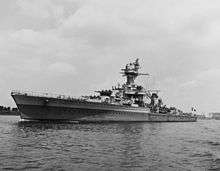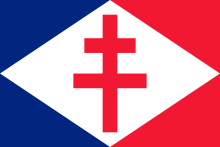Free French Naval Forces
| ||||||||||||||||
Les Forces Navales Françaises Libres ("Free French Naval Forces") were the naval arm of the Free French Forces during the Second World War. They were commanded by Admiral Émile Muselier.
History

In the wake of the Armistice and the Appeal of 18 June, Charles de Gaulle founded the Free French Forces (Forces Françaises Libres, or FFL), including a naval arm, the "Free French Naval Forces" (Les Forces Navales Françaises Libres, or FNFL). On 24 June 1940, de Gaulle made a separate call specifically to servicemen overseas to join him, and two days later the submarine Narval entered Malta and pledged its allegiance to the FFL.[1] On 30 June, De Gaulle was joined by vice-admiral Émile Muselier, who had come from Gibraltar by flying boat. Muselier was the only flag officer of the French Navy to answer the call of De Gaulle.
The French fleet was widely dispersed. Some vessels were in port in France; others had escaped from France to British controlled ports, mainly in Britain itself or Alexandria in Egypt. At the first stage of Operation Catapult, the ships in the British ports of Plymouth and Portsmouth were simply boarded on the night of 3 July 1940. The then-largest submarine in the world, the Surcouf, which had sought refuge in Portsmouth in June 1940 following the German invasion of France, resisted the British operation. In capturing the submarine, two British officers and one French sailor were killed. Other ships were the two obsolete battleships Paris and Courbet, the destroyers Triomphant and the Léopard, eight torpedo boats, five submarines (the Minerve, Junon) and a number of other ships of lesser importance.
As soon as the summer 1940, the submarines Minerve and Junon, as well as four avisos, departed from Plymouth. Towards the end of 1940, the destroyers Le Triomphant and Léopard followed. Le Triomphant sailed for New Caledonia and spent the rest of the war based there and in Australia. The ship saw action in both the Pacific and Indian Oceans.
To distinguish the FNFL from the Vichist forces, vice-admiral Émile Muselier created the bow flag displaying the French colours with a red cross of Lorraine, and a cocarde also featuring the cross of Lorraine for aircraft of the Free French Naval Air Service (Aéronavale Française Libre) and the Free French Air Force (Forces Aériennes Françaises Libres).
A number of ships were leased from the British to compensate for the lack of warships in the FNFL, among them, the Hunt class destroyer La Combattante and the Flower class corvette Aconit.
The FNFL suffered their first loss when the patrol boat Poulmic hit a mine and sank on 7 November 1940 off Plymouth.[2]
Africa
Soon after the fall of France, Free France was but a government in exile based in England, with no land of its own to speak of and very few land or sea forces. In an attempt to establish his authority on an important French territory, General de Gaulle attempted to rally French West Africa by personally sailing to Dakar with a British fleet which included a few Free French units; at the same time, a cruiser force had been sent by Vichy France to reclaim African territories which had already announced their support to De Gaulle (notably Chad). The resulting Battle of Dakar ended on a Vichist victory. However, after the occupation of full France by the Germans after the Allied invasion of North Africa in November 1942, French West Africa also eventually joined the Free French.
When it did, important ships based in Dakar were obtained: the modern battleship Richelieu, the heavy cruiser Suffren, light cruisers Gloire, Montcalm, Georges Leygues, and a few destroyers, including cruiser-sized Le Fantasque class destroyers.
Role in the French Resistance
Captain d'Estienne d'Orves attempted to unite the French Resistance, became an inspiring symbol when he was arrested, tortured by the Gestapo and executed.
D-Day: Operation Neptune

In the summer of 1944, the Invasion of Normandy took place. The FNFL took part in both naval side of the operations, Operation Neptune, and to the landing itself, with the Naval Commandos (Commandos Marine) of Captain Philippe Kieffer, climbing cliffs under fire to destroy German shore batteries.
The ships of the FNFL were deployed off the landing sites :
- Utah Beach: corvettes Aconit and Renoncule
- Omaha Beach: cruisers Georges Leygues and Montcalm; frigates Escarmouche and Aventure; and corvette Roselys
- Gold Beach: corvette Surprise
- Juno Beach: frigate Découverte; corvette Estienne d'Orves; and torpedo boat La Combattante
In addition the obsolete battleship Courbet was scuttled off Arromanches to serve as a breakwater for a Mulberry harbour.
The cruisers Georges Leygues and Montcalm, along with the battleship USS Arkansas provided fire support for the infantry until 10 June.
The Combattante silenced German coastal artillery of Courseulles-sur-Mer. The next day, she started patrolling the Channel. On 14 July, she ferried General Charles de Gaulle to France.[3]
Pacific War
The Triomphant, under the command of Philippe Auboyneau was transferred to the Pacific theatre of the war, where in February 1942 it took part in the evacuation of European and Chinese civilians and military personnel from Nauru and Ocean Island before an anticipated Japanese invasion. Triomphant was later stationed along the east coast of Australia, where in early 1943 it was involved in the rescue of the survivors from the SS Iron Knight, which was sunk by a torpedo fired by I-21. After the rescue, Triomphant then searched for I-21 for a day, but without success.
The Richelieu was present in Tokyo Bay during the signing of the Japanese Instrument of Surrender.
Technical innovations
The FNFL also harboured technical innovators, like Captain Jacques-Yves Cousteau, who invented the modern aqua-lung, and Yves Rocard, who helped perfect radar. The aqua-lung became a major improvement for commando operations. (Note - Jacques Cousteau joined the FNFL after the liberation of France. He spent the entirety of the war in France. He developed the aqua-lung in Paris during the German occupation.)
Losses
The merchant fleet of the FNFL suffered heavy casualties, amounting to one quarter of its men.
A number of warships were lost, notably the submarine Surcouf, possibly sunk in a friendly fire incident. Other losses include the destroyers Léopard, Mimosa, Alysse, and La Combattante; submarine Narval; patrol boats Poulmic and Vikings.
See also
References
- ↑ Playfair. The Mediterranean & Middle East, Volume I: The Early Successes against Italy (to May 1941) p. 137
- ↑ (French) Paul Vibert on ordredelaliberation.fr
- ↑ LA COMBATTANTE
Further reading
- Paul Auphan and Jacques Mordal, The French Navy in World War II (1976)
- Martin Thomas, "After Mers-el-Kebir: The armed neutrality of the Vichy French Navy, 1940-43," English Historical Review (1997) 112#447 pp 643–70 in JSTOR
- Spencer C. Tucker (2011). World War II at Sea: An Encyclopedi. ABC-CLIO. pp. 281–84.
External links
- (English) charles-de-gaulle.org
- (French) FNFL
- "HONOR, UNITY, SALVATION" -- FLAGS & ENSIGNS OF FREE FRANCE
- Free French Naval Forces (1940-1944)
- (French) LA MARINE MARCHANDE FNFL
